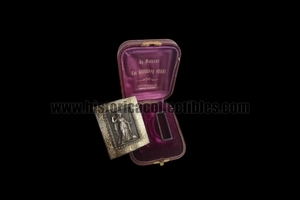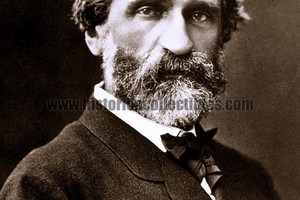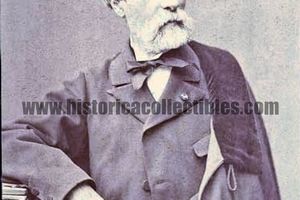Buckle in Silver, Gold and Iron (Giuseppe Franzosi), belonged to Giuseppe Verdi, 1876
Extraordinary and unique heirloom that belonged to the Maestro Cav. Giuseppe Verdi, universally considered one of the greatest musicians of all time, given to him as a gift by his oldest and most sincere friend (as Verdi wrote in one of his letters), Giulio Carcano, Italian patriot, writer, journalist and politician.
This important gift consists of a Jewel Buckle, depicting the Goddess Minerva, inventor of music and protector of musicians according to Roman mythology. This masterpiece of goldsmith's art was created by the master sculptor and engraver Giuseppe Franzosi, born in Bisuschio (VA) in 1837 and who died there prematurely in 1876 who, in his short existence, was able to masterfully shape the maximum figurative expressions in his works, so much so as to allow him to create great masterpieces intended for the Kaiser of Germany and Emperor of Prussia William I, and many other significant figures of the French and Italian nobility.
His works are currently preserved in the residences of wealthy collectors and international museums such as the Bourbon Palace in Paris, now home to the National Assembly. Furthermore, despite his great talent, his early death at just 39 years of age did not preclude him from winning the silver medal at the Universal Exhibition in Milan in 1862 by presenting a book with chiselled silver ornaments.
Cited in the Official Journal of the Kingdom of Italy 191 of 10 August 1880, 223 of 24 September 1875, and 247 of 22 October 1875, he also exhibited, in 1869 and 1874, at the Exhibition of Works of Fine Arts in the Palazzo Nazionale di Brera, in 1871 Fine Arts in Milan in 1871 and at the Universal Exhibition in Vienna in 1873.
In 1886, the widow Francesca, in the Artistic Museum of Rome, exhibited 2 absolute masterpieces created by her husband Giuseppe, who had been missing for a decade.
The buckle, made up of a polished iron plate, is expertly decorated with very fine engravings in gold. Applied to the same, a second solid silver plaque skilfully sculpted in high relief, depicting the Goddess Minerva who, among the many virtues also protector of Musicians, stands as the central topic in what appears today to be one of the most beautiful and important Known buckles.
The presence of its original case is fundamental, inside which is the dedication that Carcano made to Verdi in 1876. Absolute masterpiece.
His workshop was located in Milan, in via Ansperto, 7 and this is to be considered, in all probability, his last completed masterpiece as another of his works which had lasted for 4 years, consisting of a Precious Basin, was completed by his friend Luigi Gagliardi, another superb engraver, because Franzosi passed away.
Giuseppe Verdi he was an Italian composer and senator. He was born in Le Roncole di Busseto on 10 October 1813 to Carlo Verdi (1784-1867), innkeeper and retailer of salt and foodstuffs, and Luigia Uttini (1787-1851), spinner. Carlo came from a family of small landowners and traders residing for centuries between Villanova and Sant'Agata, who moved to Roncole di Busseto.
Giuseppe Verdi is universally recognized as one of the most important composers of opera, but also as one of the greatest composers ever.
Verdi sympathized with the Risorgimento movement which pursued the unification of Italy and actively participated for a short time in political life; over the course of his long existence he established a unique position among his compatriots, becoming a profound artistic symbol of the country's unity.
It was therefore that, a month after his death, a solemn and endless procession crossed Milan, accompanying his remains with the notes of Va, pensiero, the chorus of the Jewish slaves from Nabucco. The Va pensiero, written by him about 50 years earlier, effectively expressing the feelings of Italians towards their deceased hero, demonstrated the extent to which Verdi's music had been assimilated into the national consciousness.
Although the composer's musical influence on his successors was limited, his works still remain among the best known and most performed in theaters around the world, in particular the so-called "popular trilogy": Rigoletto (1851), Il troubadour (1853) and La traviata (1853).
Giulio Carcano (Milan, 7 August 1812 – Lesa, 30 August 1884) was an Italian politician, patriot, writer and journalist.
He was born into a noble family, the Carcanos of the Arzago branch, and was the nephew of Carlo Imbonati's sister. Collaborator of the Rivista Europea and friend of Andrea Maffei, he was among the first visitors to the salon managed by his wife Clara, bringing some exponents of patriotic periodicals there, including Gottardo Calvi.
He participated in the five days of Milan and after the new occupation by the Austrians he emigrated to Piedmont and Switzerland. Once he regained his independence, he returned to Lombardy, where he obtained public positions until his nomination as Senator in 1876.
His literary career was based on Risorgimento-based lyrics driven by a great passion, as well as on the sentimental novel entitled Ida della Torre and on the sentimental novel Angiola Maria of 1839.
His literary model of reference was established by Alessandro Manzoni, due to the presence of a moralistic streak, the attention paid to social issues and the peasant and lower middle class setting.
The relationships between Giuseppe Verdi and Giulio Carcano were linked by ancient and sincere friendship........
In 1827 Manzoni had sent him as a gift a copy of The Betrothed with a dedication in his own hand: "To the dear and promising young man". Carcano was very proud of it: “I still remember the joy and pride with which in 1827 I brought to the College a copy of the Betrothed, which the great man had sent to my mother for me; I still keep it as a domestic treasure." The precious heirloom then passed into the hands of another great poet: Giuseppe Verdi, who received it from Carcano's daughter, Maria, as a souvenir of her father who had just passed away. From his deathbed, Carcano had recommended that Verdi have that volume so dear to him. The composer was deeply moved by it. Manzoni and Carcano would become friends sharing mutual respect, the ideals of freedom and the civil passions of the Risorgimento age.
In the 1940s Carcano came into contact with the groups of patriots who gathered around Cesare Correnti, such as Carlo Tenca and the Porro brothers, who spread their ideas of independence from Austrian rule, through publications and gifts, such as the popular almanac "Il grandson of Vesta Verde". He also frequented Manzoni's house in via del Morone, where he met Niccolò Tommaseo and Giuseppe Giusti. He became a close friend of Countess Clara Maffei, who welcomed intellectuals and artists in her patriotic living room in Via Bigli for decades. He was the witness in 1846, together with Giuseppe Verdi, of Clarina's separation from the poet Andrea Maffei and it was thanks to Carcano that the woman met and fell in love with Carlo Tenca. Alongside his literary activity, Carcano worked for opposition newspapers, such as "Il Crepuscolo".
On 23 May 1848 the Provisional Government of Lombardy entrusted him with an administrative role, while Correnti was appointed general secretary. Carcano wrote the Hymn for the Dead of the Five Days, which was set to music by maestro Ronchetti Monteviti. Following the victory of Custoza, where Marshal Radetzky won against the Piedmontese army deployed by King Charles Albert, the Austrians reoccupied Milan. About 75,000 people left the city in exile. Carcano had been sent to Paris, together with the Marquis Anselmo Guerrieri Gonzaga, to ask for military help from France. Giuseppe Verdi was also in the capital, having settled in Passy in the company of Giuseppina Strepponi and who signed the appeal.
Once he regained his independence, Carcano returned to Lombardy (Italy), where he obtained public positions until his nomination as Senator in 1876. He died in Lesa on 30 August 1884.
The following September 2, the widow received a letter from Verdi: “The sudden news communicated to me breaks my heart! One of the oldest and most sincere friends left us! ... Let us mourn together the death of this holy man who was not only an esteemed poet but a model of civic and domestic virtues.
Minerva she was a Roman goddess identified with the Greek Athena. She figured in the Capitoline triad alongside Juno and Jupiter, but it does not seem that she belongs to the divinity of the primitive Latin pantheon. The term Minerva was probably imported by the Etruscans who called it Menrva. The Romans confused the foreign name with their lemma mens (mind) since the goddess governed not only war, but also intellectual activities.
Minerva was the daughter of Jupiter and Metis. She was considered by popular religiosity to be the virgin divinity of warriors, poetry, medicine, wisdom, commerce, the arts, as well as the inventor of music.
Under the term Minerva Medica, she was the protector of medicine and doctors. Adapting the Greek myth of Athena, the Romans attributed an unnatural birth to her: she was born from a terrible migraine from Jupiter. Vulcan opened her head and took out Minerva, already equipped with armor and shield.
Publius Ovid Naso defined her as a divinity with a thousand tasks. Minerva was worshiped throughout Italy, although only in Rome did she take on a warrior appearance. She is usually depicted wearing chain mail and a helmet, complete with spear.



